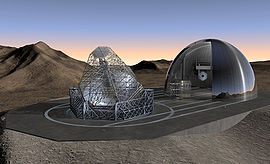- Overwhelmingly Large Telescope
-
Overwhelmingly Large Telescope 
Organization European Southern Observatory Wavelength Infrared, Visible light (0.32-12 µm) Built 2017 .. 2019 (cancelled) Telescope style Cassegrain, Coudé Diameter 60 - 100m Collecting area 2,827 - 7,854 m2 Focal length 175 m Website http://www.eso.org/sci/facilities/eelt/owl/ The Overwhelmingly Large Telescope (OWL) is a conceptual design by the European Southern Observatory (ESO) organization for an extremely large telescope, which was intended to have a single aperture of 100 meters in diameter. Because of the complexity and cost of building a telescope of this unprecedented size, ESO has elected to focus on the 39 meter diameter European Extremely Large Telescope instead.
While the original 100-m design would not exceed the angular resolving power of interferometric telescopes, it would have exceptional light-gathering and imaging capacity which would greatly increase the depth to which humankind could explore the universe. The OWL could be expected to regularly see astronomical objects with an apparent magnitude of 38; or 1,500 times fainter than the faintest object which has been detected by the Hubble Space Telescope.
All proposed designs for the OWL are variations on a segmented mirror, since there is no technology available to build a monolithic 60- or 100-meter mirror. The operation of a segmented mirror is somewhat more complicated than a monolithic one, requiring careful alignment of the segments (a technique called cophasing). Experience gained in existing segmented mirrors (for example, the Keck telescope) suggests that the mirror proposed for the OWL is feasible. However, the projected cost (of around €1.5 billion) was uncomfortably high, and the ESO is now working on a smaller European Extremely Large Telescope around 42 m in diameter.[1][2]
It has been estimated that a telescope with a diameter of 80 meters would be able to spectroscopically analyse Earth-size planets around the 40 nearest sun-like stars.[3] As such, this telescope could help in the exploration of extrasolar planets and extraterrestrial life (because the spectrum from the planets could indicate the presence of molecules indicative of life).
See also
- Active optics
- Adaptive optics
- European Extremely Large Telescope
- Extremely Large Telescope
- Giant Magellan Telescope
- List of optical telescopes
- Thirty Meter Telescope
References
- ^ http://www.eso.org/projects/e-elt/
- ^ "Record mirror for Euro telescope". BBC News. 2006-08-07. http://news.bbc.co.uk/1/hi/sci/tech/5252228.stm. Retrieved 2010-03-27.
- ^ Gilmozzi, Roberto (May 2006). "Giant Telescopes of the Future". Scientific American. http://www.sciam.com/article.cfm?id=giant-telescopes-of-the-f.
External links
- The ESO 100-m optical telescope concept
- OWL BLUE BOOK – Phase A design report
- [http://www.eso.org/projects/e-elt/
- Thinned Aperture Telescope, hundred meter aperture space telescope concept
European Southern Observatory Facilities 
Telescopes Telescope
instrumentsMiscellany Categories:- European Southern Observatory
- Telescopes
- Astronomical observatories in Chile
Wikimedia Foundation. 2010.
